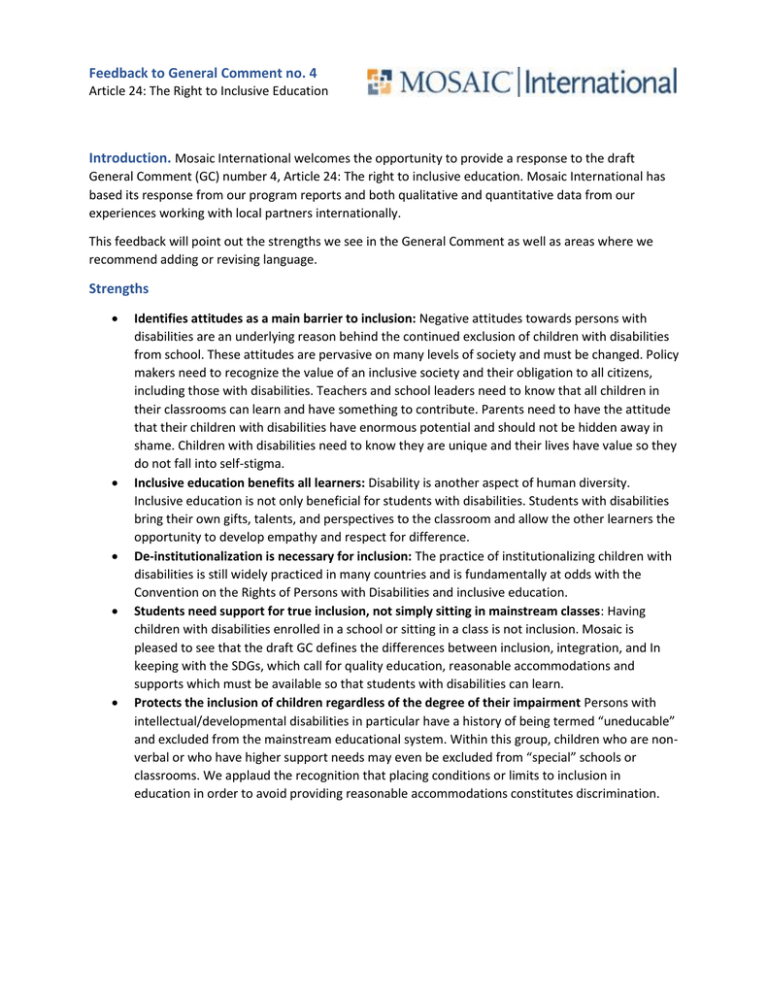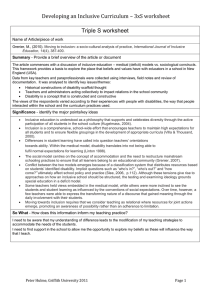Feedback to General Comment no. 4 Introduction.
advertisement

Feedback to General Comment no. 4 Article 24: The Right to Inclusive Education Introduction. Mosaic International welcomes the opportunity to provide a response to the draft General Comment (GC) number 4, Article 24: The right to inclusive education. Mosaic International has based its response from our program reports and both qualitative and quantitative data from our experiences working with local partners internationally. This feedback will point out the strengths we see in the General Comment as well as areas where we recommend adding or revising language. Strengths Identifies attitudes as a main barrier to inclusion: Negative attitudes towards persons with disabilities are an underlying reason behind the continued exclusion of children with disabilities from school. These attitudes are pervasive on many levels of society and must be changed. Policy makers need to recognize the value of an inclusive society and their obligation to all citizens, including those with disabilities. Teachers and school leaders need to know that all children in their classrooms can learn and have something to contribute. Parents need to have the attitude that their children with disabilities have enormous potential and should not be hidden away in shame. Children with disabilities need to know they are unique and their lives have value so they do not fall into self-stigma. Inclusive education benefits all learners: Disability is another aspect of human diversity. Inclusive education is not only beneficial for students with disabilities. Students with disabilities bring their own gifts, talents, and perspectives to the classroom and allow the other learners the opportunity to develop empathy and respect for difference. De-institutionalization is necessary for inclusion: The practice of institutionalizing children with disabilities is still widely practiced in many countries and is fundamentally at odds with the Convention on the Rights of Persons with Disabilities and inclusive education. Students need support for true inclusion, not simply sitting in mainstream classes: Having children with disabilities enrolled in a school or sitting in a class is not inclusion. Mosaic is pleased to see that the draft GC defines the differences between inclusion, integration, and In keeping with the SDGs, which call for quality education, reasonable accommodations and supports which must be available so that students with disabilities can learn. Protects the inclusion of children regardless of the degree of their impairment Persons with intellectual/developmental disabilities in particular have a history of being termed “uneducable” and excluded from the mainstream educational system. Within this group, children who are nonverbal or who have higher support needs may even be excluded from “special” schools or classrooms. We applaud the recognition that placing conditions or limits to inclusion in education in order to avoid providing reasonable accommodations constitutes discrimination. Areas for Improvement Technical Capacity to Implement Inclusive Education Paragraph 5: In our discussions with local education officials and head teachers we have found that they perceive real barriers in technical capacity. Even when they have changed their attitude to see the need for disability inclusion, they do not know how to implement these principles and what such a system looks like in practice. Issues include inadequate training of teachers already in schools in different inclusive education instructional strategies, lack of an inclusive curriculum and assessments, inadequate funding and infrastructure for providing supports and reasonable accommodations. These technical barriers to implementation should be recognized. ADD: Lack of technical knowledge or capacity to implement inclusive education. In systems that have never been disability inclusion, there is still insufficient knowledge of effective inclusive education models and instructional strategies. Paragraph 12e: Paragraph 12e misses an opportunity to address accessibility. A “learning friendly environment” that is not wheelchair accessible is not truly inclusive or friendly to a wheelchair user. This is also in keeping with Article 9A of the CRPD, which addresses the accessibility of public facilities such as schools. CHANGE TO: “Learning-friendly environment: Inclusive learning environments are those that are accessible to all, where everyone feels safe and comfortable, and which place a strong emphasis on involving students themselves in building a positive school community.” Paragraph 70: ADD and paraprofessionals/teachers aids Paragraph 80: Mosaic has seen in multiple contexts that schools require a parent or family member to accompany a student with a disability to serve as their aid. For families that cannot afford to hire help or have one parent not earning income, this becomes a major barrier to education access. The language, as is, could be read as support for this practice. While parents should be encouraged and allowed to volunteer in classrooms, this cannot be a loophole for education ministries to get out of their responsibility to provide reasonable accommodations. ADD: A family member’s ability to act as the child’s aid should not be a prerequisite for the child’s admission into school. Responsibility to provide reasonable accommodations rests with the education system and not with the family. Accountability for Governments and Development Programs Paragraph 39: Mosaic International has major concerns over the sentence beginning with “any deliberately retrogressive measures”. This could and would be used as a loophole for governments who see inclusive education as an unwanted or unnecessary expense. CHANGE TO “Any budget cuts or allocation of resources must not disproportionately target services to one group of students, such as reasonable accommodations for students with disabilities. This would constitute discrimination and be in violation of Article 24.” Paragraph 58: With the launch of the Sustainable Development Goals and their disability-specific targets, countries on both the giving and receiving ends of international aid will need to reform their practices to ensure disability inclusion. This is also true of multilateral international development institutions such as the World Bank. Language should reflect all avenues through which international assistance and aid may flow. REVISE TO: “The goal of inclusive education must be explicitly included in all international cooperation programmes, including those administered bi-laterally or through international development institutions and mechanisms, consistent with the SDGs and Agenda 2030 on Development, and include support for capacity building, exchange and sharing of information and best practices, research, technical and economic assistance, and facilitating access to accessible and assistive technologies. Inter-sectoral Cooperation Paragraph 54: Some habilitation/rehabilitation services that complement education or are part of a holistic view of child learning and development may not be yet considered part of the education system. In some developed countries these services are provided in schools, whereas in others they must be obtained privately, often at great expense. ADD: States parties should encourage inter-sectoral cooperation with regards to habilitation and rehabilitation services. For example, cooperative efforts between the education system and the health system to provide occupational therapy or speech therapy services, which complement education, should be provided in schools to support a child’s learning and development. Paragraph 60: This paragraph would be strengthened by explicit mention of barriers outside of the education system that are faced by children with disabilities when trying to access education. Accountability across all areas of government must also be ensured. States parties must ensure a comprehensive and inter-sectoral commitment to inclusive education across government, as it cannot be realized by education ministries in isolation. ADD: This is in recognition of the fact that many barriers to children with disabilities accessing education may fall under other ministries. For example, poor roads and lack of accessible transportation is a leading barrier to education access for children with disabilities. All relevant ministries must commit to and align their understanding of the implications of an inclusive education system in order to achieve an integrated and holistic approach where they are working collaboratively towards a shared agenda, including, but not limited to, ministries of education, finance, health, transport, planning, social welfare and child protection. ADD: Accountability measures for all ministries involved must be put into place to ensure such commitments are upheld. Cooperation and Partnership with Civil Society Paragraph 47: We would like to see mention of the role of civil society in changing attitudes. In particular we have seen that partnering with NGOs or DPOs in order to conduct disability sensitization training is a good opportunity to help school systems transitioning to inclusion. As such we recommend: ADD: In particular, cooperation with persons with disabilities and their representative organizations should be used in disability sensitization processes within the school system. Paragraph 73d: Civil society or non-profit organizations can also serve as partners to strengthen education systems and assist with the implementation of inclusive education, especially as schools are transitioning. ADD: Partnerships can be formed between neighboring educational institutions or with civil society organizations specializing in disability services, which can provide trainings and support the public education system. Inclusion in All Levels and Areas of the Education System Paragraph 55: In keeping with international efforts to promote youth employment, transition from education to employment should be mentioned. ADD: Adequate measures must be taken to plan for and support students with disabilities in their transition from school into the workforce, including access to vocational training, mentoring, apprenticeship, and tertiary education opportunities. Paragraph 57: Given the centrality of attitudes as a barrier to inclusive education, it is important to highlight the role that sport and recreation can play in facilitating social participation and decreasing stigma faced by children with disabilities. ADD (after first sentence): Furthermore, evidence suggests that inclusion in sports, recreation, and out of school activities promotes positive attitudes towards and inclusion of children with disabilities. (Reference: Dowling, S., McConkey, R., Hassan, D., & Menke, S. (2010). Unified gives us a chance: An evaluation of Special Olympics youth unified sports programme in Europe/Eurasi. Washington, DC: Special Olympics, Inc.; SDP IWG (2008), Harnessing the Power of Sport for Development and Peace: Recommendations to Governments, Chapter 5: Sport and Persons with Disabilities) Paragraph 61: Education systems are often divided among different levels and types of schools. A policy on inclusive education and requisite accountability measures must be ensured across all areas of the education system. ADD: This includes all types of facilities operated by the education ministry including: early education, primary, secondary, tertiary, and vocational education. It also includes arrangements of public-private partnerships in which education ministries cooperate with non-governmental or religious schools for the provision of education. Revise: Where such continued separation still exists, States parties must undertake urgent measures to rationalize ADD: and ensure accountability for education provision for all persons within the education ministry. ADD: States parties should have a policy on and plan of implementation for inclusive education at all levels of the education system. Paragraph 66: Many families when faced with a child newly born or diagnosed with a disability may feel pressure to institutionalize him/her as the only option for the child to receive services or education. Community-based early education and information about inclusive education can help educate families and prevent the institutionalization of children. ADD: Early education programs and information about inclusive education programs should be made available and easily accessible to families to counteract the pressure to institutionalize children. www.mosaicinternational.org facebook.com/mosaic_intl @Mosaic_Intl




